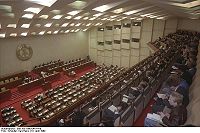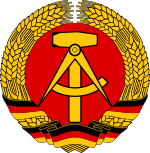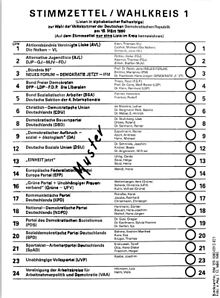- People's Chamber
-
People's Chamber
VolkskammerType Type unicameral parliament
(until 1958 lower chamber)Timeline Country German Democratic Republic (East Germany) Established 1949 Preceded by Reichstag Succeeded by Bundestag Disbanded 1990 Members 400 Meeting place 
Palast der Republik The People's Chamber (German: Volkskammer) was the unicameral legislature of the German Democratic Republic (East Germany). From its founding in 1949 until the first free elections on 18 March 1990, all members of the Volkskammer were elected on a slate controlled by the Socialist Unity Party of Germany (SED), called the National Front. Despite the appearance of a multi-party system, all these Bloc parties were effectively controlled by the dominant SED. In addition, seats were also allocated to various mass organizations affiliated with the SED, such as the Free German Youth.
Initially, it existed alongside the Chamber of States, or Länderkammer, but in 1952 the states of East Germany (and with it the chamber) were dissolved.
In theory, the Volkskammer was the highest organ of state power in the GDR. Both GDR constitutions vested it with great lawmaking powers. It also formally appointed the Council of State (after 1960), the Council of Ministers, and the National Defence Council.
In practice, like most other legislatures in Communist countries, the People's Chamber did little more than rubber-stamp decisions already made by the SED. All parties were expected to respect democratic centralism, and the most dissent in voting ever shown by the Volkskammer to the SED were fourteen nays and eight abstentions on the part of CDU representatives in a vote on liberalising abortion law.
A typical slate was as follows:
Party/Group Acronym Members Socialist Unity Party of Germany SED 127 Free German Trade Union Federation FDGB 68 Christian Democratic Union CDU 52 Liberal Democratic Party of Germany LDPD 52 Democratic Farmers' Party of Germany DBD 52 National Democratic Party of Germany NDPD 52 Free German Youth FDJ 50 Democratic Women's League of Germany DFD 35 Cultural Association of the DDR KB 22 In 1976, the Volkskammer moved into a specially-constructed building on Marx-Engels-Platz (now Schloßplatz again), the Palast der Republik (Palace of the Republic).
After the 1990 elections, the disposition of the parties was as follows:
Party/Group Acronym Members Alliance for Germany CDU, DA, DSU 192 Social Democratic Party of Germany SPD 88 Party of Democratic Socialism PDS, former SED 66 Association of Free Democrats DFP, FDP, LDP 21 Alliance 90 B90 12 East German Green Party and Independent Women's Association Grüne, UFV 8 National Democratic Party of Germany NDPD 2 Democratic Women's League of Germany DFD 1 United Left VL 1 Chairmen of the People's Chamber
List of Presidents of the People's Chamber
Below is a list of office-holders:
Name Entered office Left office Party Johannes Dieckmann October 7, 1949 February 22, 1969 LDPD Gerald Götting May 12, 1969 October 29, 1976 CDU Horst Sindermann October 29, 1976 November 13, 1989 SED Günther Maleuda November 13, 1989 April 5, 1990 DBD Sabine Bergmann-Pohl April 5, 1990 October 2, 1990 CDU Sabine-Bergmann-Pohl was also head of state of the German Democratic Republic, due to the State Council having been abolished.
See also
- List of Presidents of the People's Chamber
- Presidium of the People's Chamber
External links
 Elections in East Germany
Elections in East GermanyGeneral elections 1950 · 1954 · 1958 · 1963 · 1967 · 1971 · 1976 · 1981 · 1986 · 1990Referendums 1968Categories:- Government of East Germany
- Defunct unicameral legislatures
- 1949 establishments in East Germany
- 1990 disestablishments
- German organisation stubs
Wikimedia Foundation. 2010.



